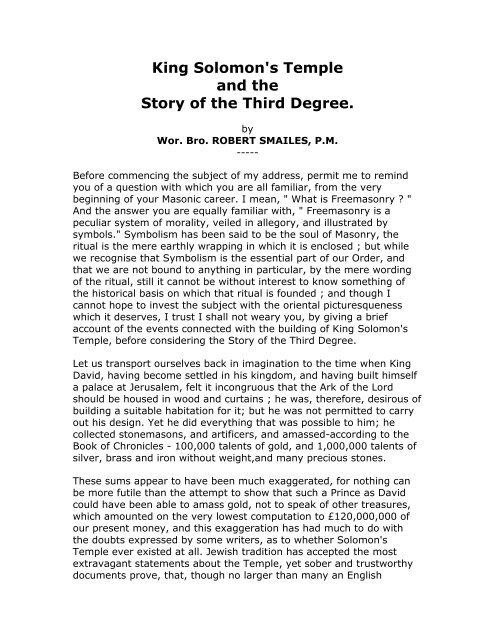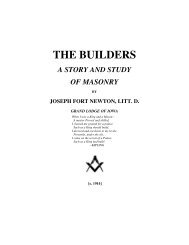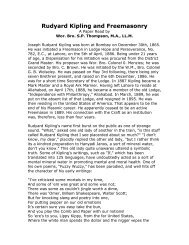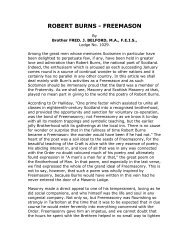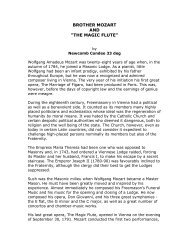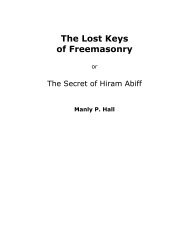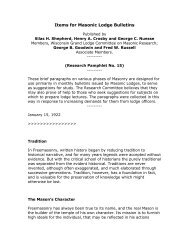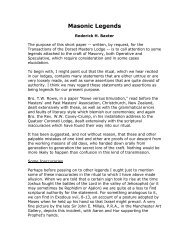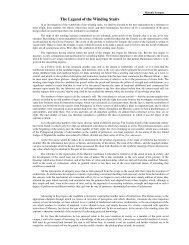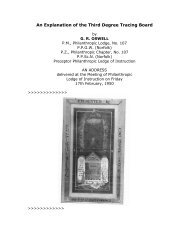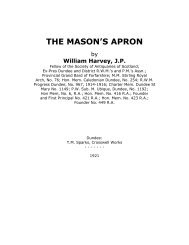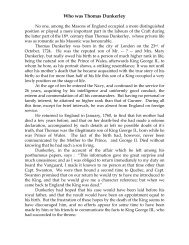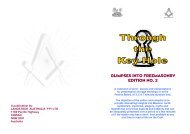King Solomon's Temple and the Story of the ... - RoseCroix.org.au
King Solomon's Temple and the Story of the ... - RoseCroix.org.au
King Solomon's Temple and the Story of the ... - RoseCroix.org.au
- No tags were found...
Create successful ePaper yourself
Turn your PDF publications into a flip-book with our unique Google optimized e-Paper software.
<strong>King</strong> <strong>Solomon's</strong> <strong>Temple</strong><strong>and</strong> <strong>the</strong><strong>Story</strong> <strong>of</strong> <strong>the</strong> Third Degree.byWor. Bro. ROBERT SMAILES, P.M.-----Before commencing <strong>the</strong> subject <strong>of</strong> my address, permit me to remindyou <strong>of</strong> a question with which you are all familiar, from <strong>the</strong> verybeginning <strong>of</strong> your Masonic career. I mean, " What is Freemasonry ? "And <strong>the</strong> answer you are equally familiar with, " Freemasonry is apeculiar system <strong>of</strong> morality, veiled in allegory, <strong>and</strong> illustrated bysymbols." Symbolism has been said to be <strong>the</strong> soul <strong>of</strong> Masonry, <strong>the</strong>ritual is <strong>the</strong> mere earthly wrapping in which it is enclosed ; but whilewe recognise that Symbolism is <strong>the</strong> essential part <strong>of</strong> our Order, <strong>and</strong>that we are not bound to anything in particular, by <strong>the</strong> mere wording<strong>of</strong> <strong>the</strong> ritual, still it cannot be without interest to know something <strong>of</strong><strong>the</strong> historical basis on which that ritual is founded ; <strong>and</strong> though Icannot hope to invest <strong>the</strong> subject with <strong>the</strong> oriental picturesquenesswhich it deserves, I trust I shall not weary you, by giving a briefaccount <strong>of</strong> <strong>the</strong> events connected with <strong>the</strong> building <strong>of</strong> <strong>King</strong> <strong>Solomon's</strong><strong>Temple</strong>, before considering <strong>the</strong> <strong>Story</strong> <strong>of</strong> <strong>the</strong> Third Degree.Let us transport ourselves back in imagination to <strong>the</strong> time when <strong>King</strong>David, having become settled in his kingdom, <strong>and</strong> having built himselfa palace at Jerusalem, felt it incongruous that <strong>the</strong> Ark <strong>of</strong> <strong>the</strong> Lordshould be housed in wood <strong>and</strong> curtains ; he was, <strong>the</strong>refore, desirous <strong>of</strong>building a suitable habitation for it; but he was not permitted to carryout his design. Yet he did everything that was possible to him; hecollected stonemasons, <strong>and</strong> artificers, <strong>and</strong> amassed-according to <strong>the</strong>Book <strong>of</strong> Chronicles - 100,000 talents <strong>of</strong> gold, <strong>and</strong> 1,000,000 talents <strong>of</strong>silver, brass <strong>and</strong> iron without weight,<strong>and</strong> many precious stones.These sums appear to have been much exaggerated, for nothing canbe more futile than <strong>the</strong> attempt to show that such a Prince as Davidcould have been able to amass gold, not to speak <strong>of</strong> o<strong>the</strong>r treasures,which amounted on <strong>the</strong> very lowest computation to £120,000,000 <strong>of</strong>our present money, <strong>and</strong> this exaggeration has had much to do with<strong>the</strong> doubts expressed by some writers, as to whe<strong>the</strong>r <strong>Solomon's</strong><strong>Temple</strong> ever existed at all. Jewish tradition has accepted <strong>the</strong> mostextravagant statements about <strong>the</strong> <strong>Temple</strong>, yet sober <strong>and</strong> trustworthydocuments prove, that, though no larger than many an English
Mount Moriah was found to be a very difficult site for such a building ;<strong>the</strong> sides <strong>of</strong> <strong>the</strong> hill were steep, its summit was rough <strong>and</strong> <strong>of</strong>insufficient size for <strong>the</strong> forecourts <strong>of</strong> <strong>the</strong> house. These courts had to besupported by immense walls, which have partly survived <strong>the</strong> ravages<strong>of</strong> many conquests. For <strong>the</strong> skilled work <strong>the</strong> <strong>King</strong> had to rely onSidonian workmen, among whom special mention is made <strong>of</strong> <strong>the</strong>GIBLITES (A.V. stonesquarers), <strong>the</strong> people <strong>of</strong> Gebal, or Byblos, whichwas north <strong>of</strong> Berytos, <strong>and</strong> nearest to <strong>the</strong> Cedars <strong>of</strong> Lebanon. Ezekiellong afterwards mentions <strong>the</strong> wisdom <strong>and</strong> artistic genius <strong>of</strong> thisPhoenician community. Even in Homer, <strong>the</strong> Sidonians are famed forembroidered robes, <strong>and</strong> skill in workmanship. In addition to so large ahost <strong>of</strong> workmen, o<strong>the</strong>rs were engaged in casting bronze in ear<strong>the</strong>nmoulds ; this was done in <strong>the</strong> clay soil <strong>of</strong> <strong>the</strong> Valley <strong>of</strong> Jordan, betweenZarthan or Zeredathah, <strong>and</strong> Succoth, <strong>and</strong> <strong>the</strong> superintendent <strong>of</strong> all wasHIRAM ABIF.The character <strong>of</strong> <strong>the</strong> architecture, both inside <strong>and</strong> out, wasundoubtedly Phoenician. From Tyre, too, came <strong>the</strong> use <strong>of</strong> curtains,dyed in <strong>the</strong> scarlet juice <strong>of</strong> <strong>the</strong> trumpet-fish, <strong>and</strong> o<strong>the</strong>r costly dyes. Weknow that inside <strong>the</strong> <strong>Temple</strong> no stone was visible, all was <strong>of</strong> gildedcedar- wood, cypress, <strong>and</strong> olive, variously carved, <strong>and</strong> tapestried inparts by purple <strong>and</strong> embroidered hangings. Strangely enough, existingrecords leave us entirely in <strong>the</strong> dark as to <strong>the</strong> external appearance <strong>of</strong><strong>the</strong> <strong>Temple</strong>, <strong>and</strong> it is unnecessary to go into <strong>the</strong> various speculationson <strong>the</strong> subject.Let us try to represent, says Dean Farrar, what a visitor would haveseen, had he been permitted to w<strong>and</strong>er into <strong>the</strong> sacred courts <strong>and</strong>buildings <strong>of</strong> this most celebrated <strong>of</strong> earthly shrines. Passing through<strong>the</strong> thickly clustering houses <strong>of</strong> <strong>the</strong> Levites <strong>and</strong> <strong>the</strong> Porticoes, he mightenter <strong>the</strong> <strong>Temple</strong> by one <strong>of</strong> <strong>the</strong> numerous gateways mentioned in <strong>the</strong>Book <strong>of</strong> Chronicles <strong>and</strong> elsewhere.Two gates did Solomon construct, devoted to acts <strong>of</strong> mercy. Throughone gate <strong>the</strong> bridegrooms used to pass, through <strong>the</strong> o<strong>the</strong>r <strong>the</strong>mourners. The people on <strong>the</strong> Sabbath rejoiced with <strong>the</strong> bridegrooms,<strong>and</strong> consoled <strong>the</strong> afflicted. These gates were <strong>of</strong> wood, overlaid withbrass. When <strong>the</strong> visitor stood in <strong>the</strong> outer court, he would have seenon one side <strong>of</strong> <strong>the</strong> <strong>Temple</strong> area, a grove <strong>of</strong> trees, Olives, Palms,Cedars, <strong>and</strong> Cypresses, which added to <strong>the</strong> be<strong>au</strong>ty <strong>of</strong> <strong>the</strong> building, butwere afterwards abused for idolatrous purposes. To pass from <strong>the</strong>outer court, into <strong>the</strong> court which Jeremiah calls " <strong>the</strong> higher court," <strong>the</strong>visitor would have had to pass up some steps, through an enclosurebuilt with three rows <strong>of</strong> hewn stones, supported by a cornice <strong>of</strong> Cedar
eams. On <strong>the</strong> south-eastern side he would have admired <strong>the</strong> hugelaver or basin, for <strong>the</strong> ablutions <strong>of</strong> <strong>the</strong> priests, which was regarded asone <strong>of</strong> <strong>the</strong> finest specimens <strong>of</strong> <strong>the</strong> skill <strong>of</strong> HIRAM ABIF. It was made <strong>of</strong>brass, <strong>and</strong> was known as " <strong>the</strong> brazen or molten sea." It had a length<strong>and</strong> breadth <strong>of</strong> 45 feet, <strong>and</strong> stood 7½ feet high, on <strong>the</strong> backs <strong>of</strong> 12brazen oxen <strong>of</strong> <strong>the</strong> same height, <strong>of</strong> which three faced to each quarter<strong>of</strong> <strong>the</strong> heavens.Approaching <strong>the</strong> porch, <strong>the</strong> eye would have been first c<strong>au</strong>ght by twosuperb pillars, which were regarded in those days as a miracle <strong>of</strong> art,<strong>and</strong> which for unknown reasons, received <strong>the</strong> name <strong>of</strong> Jachin <strong>and</strong>Boaz. Strange to say, it is a matter <strong>of</strong> dispute whe<strong>the</strong>r <strong>the</strong>se twopillars stood detached from <strong>the</strong> porch, or were mere ornaments withinit, or formed part <strong>of</strong> its absolute support, or, as is now believed bymany, belonged to a detached gate in front <strong>of</strong> <strong>the</strong> porch itself.Ferguson, in his latest designs, supposed that <strong>the</strong> pillars were notdetached like obelisks, but that <strong>the</strong>y supported a screen or gateway,like <strong>the</strong> vine-bearing screen, described by Josephus <strong>and</strong> <strong>the</strong> Talmud, infront <strong>of</strong> <strong>the</strong> <strong>Temple</strong> <strong>of</strong> Herod. They were broken up <strong>and</strong> carried away,four centuries later, by <strong>the</strong> <strong>King</strong> <strong>of</strong> Babylon.The <strong>Temple</strong> itself was surrounded on two sides by three storeys <strong>of</strong>chambers. A winding stair led up into <strong>the</strong> middle chamber <strong>of</strong> <strong>the</strong>middle storey, <strong>and</strong> <strong>the</strong>nce into <strong>the</strong> upper storey. These chamberscommunicated with each o<strong>the</strong>r, <strong>and</strong> were, according to Josephus,thirty in number ; <strong>the</strong>y were useful for a multitude <strong>of</strong> purposes ; itdoes not appear that <strong>the</strong>y were ever inhabited, but <strong>the</strong>y served asstore rooms for <strong>the</strong> priests' garments, <strong>and</strong> for <strong>the</strong> immenseaccumulations <strong>of</strong> <strong>Temple</strong> furniture. You will remember, it was up thiswinding staircase, our Ancient Fellow Craft Brethren are said to havegone to receive <strong>the</strong>ir wages.I need not go fur<strong>the</strong>r into <strong>the</strong> construction <strong>of</strong> <strong>the</strong> <strong>Temple</strong>, except tosay that <strong>the</strong> holiest place was plunged in unbroken <strong>and</strong> perpetualgloom. It contained nothing but <strong>the</strong> Ark, <strong>and</strong> one or two o<strong>the</strong>r preciousmemorials <strong>of</strong> <strong>the</strong> Mosaic age.The whole structure was completed in sacred silence. The awfulsanctity <strong>of</strong> <strong>the</strong> shrine would have been violated, if its erection hadbeen accompanied by <strong>the</strong> harsh <strong>and</strong> violent noises which wouldaccompany <strong>the</strong> ordinary toil <strong>of</strong> masons ; every stone <strong>and</strong> beam hadbeen <strong>the</strong>refore carefully prepared beforeh<strong>and</strong>, <strong>and</strong> was merely carriedto its place, " so that nei<strong>the</strong>r was hammer, nor axe, nor any tool <strong>of</strong>iron heard in <strong>the</strong> house while it was building." The erection occupied
seven-<strong>and</strong>-a-half years, in spite <strong>of</strong> <strong>the</strong> small size <strong>of</strong> <strong>the</strong> actual <strong>Temple</strong>.Size indeed, was no element <strong>of</strong> its magnificence, for, as I have said, itwas much smaller than many an English Church. But it must beremembered it was not intended for ei<strong>the</strong>r priests or worshippers.Ancient <strong>and</strong> Eastern worship was mainly in <strong>the</strong> open air ; <strong>the</strong> Shrineitself only symbolised <strong>the</strong> residence <strong>of</strong> God.And so <strong>the</strong> <strong>Temple</strong> was completed, <strong>and</strong> after a fur<strong>the</strong>r period <strong>of</strong> twelvemonths, for preparation, came <strong>the</strong> most magnificent ceremony <strong>the</strong>nation had ever known, viz. <strong>the</strong> Dedication, culminating in <strong>the</strong>be<strong>au</strong>tiful prayer <strong>of</strong> Solomon, with <strong>the</strong> constantly recurring refrain,"Hear, Thou in Heaven, Thy dwelling-place, <strong>and</strong> when Thou hearest,Lord, f<strong>org</strong>ive.""Sacred to Heaven behold <strong>the</strong> dome appears,"Lo, what <strong>au</strong>gust solemnity it wears."Angels <strong>the</strong>mselves have deigned to deck <strong>the</strong> fane,"And be<strong>au</strong>teous Sheba shall proclaim its fame."The <strong>Temple</strong> was <strong>the</strong>nceforth <strong>the</strong> centre <strong>of</strong> all <strong>the</strong> national life <strong>of</strong> <strong>the</strong>Jews, <strong>and</strong> that centre was no idol shrine, no material image, but <strong>the</strong>symbolic palace <strong>of</strong> Him, whom Heaven <strong>and</strong> <strong>the</strong> Heaven <strong>of</strong> Heavenscould not contain.Passing over <strong>the</strong> visit <strong>of</strong> <strong>the</strong> Queen <strong>of</strong> Sheba, we must carry <strong>the</strong>history <strong>of</strong> Solomon a little far<strong>the</strong>r ; he continued his buildingoperations for a period <strong>of</strong> twenty years, at <strong>the</strong> end <strong>of</strong> which time <strong>the</strong><strong>King</strong> <strong>of</strong> Tyre thought <strong>the</strong>y ought to have a squaring-up, when it wasfound that Solomon was considerably indebted to him, <strong>and</strong> also that<strong>the</strong> exchequer was empty. Solomon, however, made Hiram a present<strong>of</strong> some country next to Phoenicia with which at first Hiram was verypleased, but when he went to view it, he found it worthless, <strong>and</strong> tha<strong>the</strong> had been over-reached. Notwithst<strong>and</strong>ing this diplomatic breeze, nobreach appears to have been made in <strong>the</strong> friendship <strong>of</strong> <strong>the</strong> two <strong>King</strong>s.Jewish writers in less ancient times cannot overlook HIRAM'Suncircumcision in his services towards building <strong>the</strong> <strong>Temple</strong>. Theirlegends relate, that bec<strong>au</strong>se he was a God-fearing man, <strong>and</strong> built <strong>the</strong><strong>Temple</strong>, he was received alive into Paradise, but that after he hadbeen <strong>the</strong>re a thous<strong>and</strong> years, he sinned by pride, <strong>and</strong> was thrust downinto hell.You will notice, that while we have this legend about <strong>the</strong> KING <strong>of</strong>TYRE, <strong>and</strong> <strong>the</strong> <strong>au</strong><strong>the</strong>ntic record <strong>of</strong> <strong>the</strong> death <strong>of</strong> ADONIRAM by stoning,
<strong>the</strong>re is nothing to indicate <strong>the</strong> end <strong>of</strong> HIRAM ABIF. It has been urgedby some that <strong>the</strong>re were two architects, fa<strong>the</strong>r <strong>and</strong> son, <strong>and</strong> that <strong>the</strong>fa<strong>the</strong>r was killed as stated in our ritual, <strong>and</strong> succeeded by <strong>the</strong> son.This <strong>the</strong>ory is based on what I think is a wrong translation <strong>of</strong> <strong>the</strong> word"Abif," <strong>and</strong> occurs in <strong>the</strong> message from <strong>the</strong> KING OF TYRE toSOLOMON : "And now I have sent a cunning man, endued withunderst<strong>and</strong>ing <strong>of</strong> Hiram, my fa<strong>the</strong>r's."Abif is a compound name : "Ab,"meaning "fa<strong>the</strong>r,"is a token <strong>of</strong> respect, <strong>and</strong> "I," or "If," <strong>the</strong> definitearticle, <strong>and</strong> is not intended merely in <strong>the</strong> parental sense, as Abraham,<strong>the</strong> fa<strong>the</strong>r <strong>of</strong> <strong>the</strong> faithful, but Abif is more properly <strong>the</strong> fa<strong>the</strong>r or masterbuilder. I think we are bound to conclude <strong>the</strong>re was only one greatarchitect for <strong>the</strong> <strong>Temple</strong>, <strong>and</strong> this prototype <strong>of</strong> our Order disappearsvery modestly from view in <strong>the</strong> simple words recorded in <strong>the</strong> Book <strong>of</strong>Chronicles, "And HURAM finished <strong>the</strong> work he had to make for KINGSOLOMON for <strong>the</strong> House <strong>of</strong> God."And now we will change <strong>the</strong> scene from this vision <strong>of</strong> Easternsplendour, to <strong>the</strong> more sombre atmosphere <strong>of</strong> London, at <strong>the</strong>beginning <strong>of</strong> <strong>the</strong> eighteenth century, when four Lodges, meeting atsuch quaint houses as "The Goose <strong>and</strong> Gridiron," "The Rummer <strong>and</strong>Grapes," <strong>the</strong> "Apple Tree Tavern," <strong>and</strong> <strong>the</strong> "Crown Ale-house," decidedto form <strong>the</strong>mselves into a GRAND LODGE in order to reform <strong>and</strong>re<strong>org</strong>anise Freemasonry in accordance with <strong>the</strong> spirit <strong>of</strong> <strong>the</strong> age, <strong>of</strong>which Lodge ANTHONY SAYER was elected Gr<strong>and</strong> Master in 1717.Of <strong>the</strong> men who took part in this re<strong>org</strong>anisation, <strong>the</strong> three mosteminent were Dr. Theoph. Desaguliers, <strong>the</strong> Rev. James Anderson, <strong>and</strong>Ge<strong>org</strong>e Payne. Payne was <strong>the</strong> second Gr<strong>and</strong> Master in 1718. Andersonwas afterwards asked to write <strong>the</strong> Book <strong>of</strong> Constitutions. Desagulierswas third Gr<strong>and</strong> Master, <strong>and</strong> <strong>of</strong> this triumvirate, probably <strong>the</strong> mostimportant. He was <strong>the</strong> son <strong>of</strong> a French Protestant Minister, <strong>and</strong> wasborn at Rochelle in 1683. After <strong>the</strong> edict <strong>of</strong> Nantes, he with his fa<strong>the</strong>rcame to London in 1685. His education was finished at Oxford, <strong>and</strong> in<strong>the</strong> course <strong>of</strong> time he attained considerable notoriety as ama<strong>the</strong>matician <strong>and</strong> natural philosopher. In 1705 he gave a course <strong>of</strong>public lectures on experimental philosophy, which were attended bypersons <strong>of</strong> all classes <strong>of</strong> society. In 1723 he was commissioned byParliament to devise a plan for heating <strong>and</strong> ventilating <strong>the</strong> House <strong>of</strong>Commons, which he effected in a very ingenious manner. There aresome occurrences in <strong>the</strong> life <strong>of</strong> Desaguliers which merit particularattention, as having exercised a peculiar influence on <strong>the</strong> Masonry <strong>of</strong>his day. His love <strong>of</strong> mechanics, <strong>and</strong> <strong>the</strong> prominent part which thatscience plays in operative Masonry, no doubt induced him to become amember <strong>of</strong> <strong>the</strong> Fraternity. He soon, however, found <strong>the</strong> Brethren could
teach him nothing. On <strong>the</strong> o<strong>the</strong>r h<strong>and</strong>, <strong>the</strong> spirit <strong>of</strong> toleration which hefound prevailing among <strong>the</strong> members <strong>of</strong> <strong>the</strong> Fraternity, peculiarlygrateful to one who had suffered from religious intolerance, inspiredhim with <strong>the</strong> idea <strong>of</strong> reconstructing <strong>the</strong> Society on a basis which shouldunite toge<strong>the</strong>r in harmony, those who were divided by religious <strong>and</strong>political schisms. In carrying out his plan, he was materially aided by<strong>the</strong> high position he held in society, <strong>and</strong> by <strong>the</strong> widespreadacquaintance he enjoyed. As a French refugee he was, <strong>of</strong> course, azealous Protestant, <strong>and</strong> this fact must have influenced him in makingalterations in <strong>the</strong> ritual <strong>of</strong> Masonry, in which several changes weremade subsequent to 1717, for <strong>the</strong> purpose <strong>of</strong> divesting it <strong>of</strong> some <strong>of</strong><strong>the</strong> lingering remnants <strong>of</strong> Romanism.Of <strong>the</strong>se changes, <strong>the</strong> most important was <strong>the</strong> fundamental one whichis at <strong>the</strong> root <strong>of</strong> our present system that <strong>of</strong> belief. You will remember<strong>the</strong> old Charges all began with an invocation to <strong>the</strong> Trinity; later thisseems to have been changed to God <strong>and</strong> <strong>the</strong> Holy Church; <strong>the</strong> latterwas now dropped, <strong>and</strong> a simple belief in <strong>the</strong> Deity only imposed oninitiates. One cannot help thinking that <strong>the</strong> leaders <strong>of</strong> <strong>the</strong> movementbelonged to <strong>the</strong> Latitudinarian School <strong>of</strong> Theology, as this school wasdistinguished from both Puritans <strong>and</strong> High Churchmen by <strong>the</strong>iropposition to dogma, <strong>and</strong> by <strong>the</strong>ir preference <strong>of</strong> reason to tradition, anexample <strong>of</strong> which we have in that be<strong>au</strong>tiful portion <strong>of</strong> <strong>the</strong> ritual, wherewe are forcibly impressed to "listen to <strong>the</strong> dictates <strong>of</strong> reason."A PHILOSOPHICAL ESSAY ON DEATH.The <strong>Story</strong> <strong>of</strong> <strong>the</strong> Third Degree is a philosophical essay on Death, inwhich is recited <strong>the</strong> supposed death <strong>of</strong> Hiram Abif, at or about <strong>the</strong>completion <strong>of</strong> <strong>King</strong> <strong>Solomon's</strong> <strong>Temple</strong>, <strong>and</strong> just as it is <strong>the</strong> sum <strong>of</strong> <strong>the</strong>small which makes <strong>the</strong> large, <strong>and</strong> a simple word may plant <strong>the</strong> seedwhich, in its time, blossoms into fragrant action, <strong>and</strong> alters <strong>the</strong> courses<strong>of</strong> lives, rounding life itself into its fullest be<strong>au</strong>ty, so this tragedy <strong>of</strong> <strong>the</strong>Tyrian architect has blossomed into an Order, whose branches areextended over <strong>the</strong> whole surface <strong>of</strong> <strong>the</strong> habitable globe, <strong>and</strong> <strong>of</strong> whichwe are justly proud.We have seen, however, that <strong>the</strong>re is no historical foundation for thisstory, <strong>and</strong> I have it on <strong>the</strong> <strong>au</strong>thority <strong>of</strong> Bro. HUGHAN, thatritualistically HIRAM ABIF is unknown before <strong>the</strong> THIRD DEGREE, <strong>and</strong>this has not been traced before 1723-7. Many eminent Masons havesought for <strong>the</strong> story in <strong>the</strong> Miracle Plays <strong>of</strong> <strong>the</strong> Middle Ages, butwithout success. The question <strong>the</strong>n arises, Was <strong>the</strong> story entirelyoriginated by <strong>the</strong> compilers <strong>of</strong> <strong>the</strong> new ritual, or was <strong>the</strong>re some
foundation for it existing in <strong>the</strong> CRAFT GUILDS before <strong>the</strong> formation <strong>of</strong>GRAND LODGE?It is not to be supposed that Brethren, who a generation later, split upon very simple points into Ancients <strong>and</strong> Moderns, would allow anentirely new legend to be introduced into Freemasonry, <strong>and</strong> I think<strong>the</strong>re is sufficient evidence to prove that some story <strong>of</strong> HIRAM, <strong>the</strong>Builder, was known to Masons before this period.In <strong>the</strong> account <strong>of</strong> <strong>the</strong> Installation <strong>of</strong> <strong>the</strong> DUKE OF MONTAGU as Gr<strong>and</strong>Master in 1721, we read that "immediately afterwards, as ifunpremeditatedly, <strong>the</strong> Gr<strong>and</strong> Master Montagu nominated Dr. JohnBeal, Deputy Gr<strong>and</strong> Master, who was invested <strong>and</strong> installed into <strong>the</strong>chair <strong>of</strong> HIRAM ABIF, to <strong>the</strong> left h<strong>and</strong> <strong>of</strong> <strong>the</strong> Gr<strong>and</strong> Master.Pr<strong>of</strong>essor Swift Johnson has made a study <strong>of</strong> <strong>the</strong> literature <strong>of</strong> <strong>the</strong> 17thcentury, with a view <strong>of</strong> tracing <strong>the</strong> introduction <strong>of</strong> <strong>the</strong> legend duringthat period, but without success. In a paper read before <strong>the</strong> Q.C.Lodge, he says:"As a result <strong>of</strong> such search as I have made in <strong>the</strong> subject put beforeyou, we may safely conclude that in <strong>the</strong> 17th century, <strong>the</strong> description<strong>of</strong> <strong>King</strong> <strong>Solomon's</strong> <strong>Temple</strong> excited a very considerable amount <strong>of</strong>attention <strong>and</strong> interest; but that in <strong>the</strong> writings that appeared, <strong>the</strong>rewas little, if anything, <strong>of</strong> Masonic importance. The result may be calleda failure, were it not that we should always bear in mind <strong>the</strong> soundBaconian maxim, that <strong>the</strong> negative instance is always more valuablethan <strong>the</strong> positive. It shows that <strong>the</strong> legends were not taken wholesaleinto our system from an outside source <strong>of</strong> current knowledge, <strong>and</strong>leaves us with <strong>the</strong> alternative that this characteristic <strong>of</strong> our Craft wasei<strong>the</strong>r part <strong>and</strong> parcel <strong>of</strong> <strong>the</strong> ancient teaching, or that it was anaddition made at or about <strong>the</strong> beginning <strong>of</strong> modern Masonry."Looking fur<strong>the</strong>r back, we find that in <strong>the</strong> first English Bible, publishedby Coverdale in 1535, Hiram, <strong>the</strong> architect, is <strong>the</strong>re spoken <strong>of</strong> asHiram Abif, but in all <strong>the</strong> succeeding translations <strong>the</strong> "Abif " is omitted,<strong>and</strong> only reappears to our knowledge in Masonry in 1721, so it is fairto presume, it had been h<strong>and</strong>ed down orally, through <strong>the</strong> Masons from<strong>the</strong> former time.Then <strong>the</strong>re is what is known as Dr. MARKS' wonderful discovery. Dr.Marks was not a Mason, but a celebrated Hebrew scholar, <strong>and</strong> in hisresearches at Oxford, he came across an Arabic Manuscript <strong>of</strong> <strong>the</strong> 14thcentury, in which reference is made to a Masonic sign or password,
<strong>and</strong> which, translated, would read, "We have found our Lord Hiram."Bro. Hughan writes me, "Long before such an announcement, a JewishRabbi explained just such a reading to Capt. Philips 33° <strong>and</strong> myself."Looking abroad for evidence, we find in France a Society called "LesCompanions du tour de France," which was divided into three, "Sons <strong>of</strong>Solomon," "Pere Soubise," <strong>and</strong> "Maitre Jacques," <strong>and</strong> included o<strong>the</strong>rtrades besides Masons. PERDIGUIER, a French writer, informs us "that<strong>the</strong> joiners <strong>of</strong> Maitre Jacques wear white gloves, bec<strong>au</strong>se, as <strong>the</strong>y say,<strong>the</strong>y did not steep <strong>the</strong>ir h<strong>and</strong>s in <strong>the</strong> blood <strong>of</strong> Hiram." Also apropos <strong>of</strong>"chien," a title bestowed on some <strong>of</strong> <strong>the</strong> Companions, he says, "It isbelieved by some, to be derived from <strong>the</strong> fact, that it was a dog whichdiscovered <strong>the</strong> place where <strong>the</strong> body <strong>of</strong> Hiram, <strong>the</strong> Architect <strong>of</strong> <strong>the</strong><strong>Temple</strong>, lay under <strong>the</strong> rubbish ; after which, all <strong>the</strong> Companions whoseparated from <strong>the</strong> murderers <strong>of</strong> Hiram, were called `chiens' or dogs."I think you will agree that we have some evidence <strong>of</strong> a legend <strong>of</strong> <strong>the</strong>death <strong>of</strong> Hiram existing before Gr<strong>and</strong> Lodge era. When could such atale have been incorporated into Medieval Masonry? The late Bro.SPETH once said:"I can see no epoch more likely than that <strong>of</strong> <strong>the</strong> return from <strong>the</strong>Crusades. The Knights <strong>of</strong> <strong>the</strong> Cross were enthusiastic builders ; <strong>the</strong>remains <strong>of</strong> <strong>the</strong>ir Churches dot <strong>the</strong> Holy L<strong>and</strong> to this day. The Europeanbuilders must, in <strong>the</strong> nature <strong>of</strong> things, have required large numbers <strong>of</strong>native workmen to assist <strong>the</strong>m, <strong>and</strong> among <strong>the</strong>se <strong>the</strong> <strong>Temple</strong> legend,if it existed, would certainly be known. The builders, on <strong>the</strong>ir return,would have brought <strong>the</strong> legend with <strong>the</strong>m, <strong>and</strong> it would have beenadopted all <strong>the</strong> more readily, as it was in perfect accord with <strong>the</strong>traditions, aye, even <strong>of</strong> <strong>the</strong> practices, <strong>of</strong> that age in Engl<strong>and</strong>."Ano<strong>the</strong>r factor in <strong>the</strong> construction <strong>of</strong> <strong>the</strong> <strong>Story</strong> <strong>of</strong> <strong>the</strong> Third Degree was<strong>the</strong> exhibition <strong>of</strong> a large model <strong>of</strong> <strong>King</strong> <strong>Solomon's</strong> <strong>Temple</strong> in London, in1724.As Pr<strong>of</strong>. Swift Johnson has told us, <strong>the</strong> <strong>Temple</strong> seems to havecaptivated <strong>the</strong> imagination <strong>of</strong> a large number <strong>of</strong> writers during <strong>the</strong>17th century, both in Engl<strong>and</strong> <strong>and</strong> on <strong>the</strong> continent. Among <strong>the</strong> latter,a Spanish Jesuit, called VILLALPANDUS, was <strong>the</strong> most eminent. Inobedience to a royal comm<strong>and</strong>, he drew up a description <strong>of</strong> <strong>the</strong><strong>Temple</strong>, <strong>and</strong> regarding <strong>the</strong> plan as being given by <strong>the</strong> Most High to <strong>the</strong>wisest <strong>of</strong> <strong>King</strong>s, he incorporated in his account all those excellencies hedeemed essential to a most perfect edifice; <strong>and</strong> this description waspractically repeated by Bishop WALTON in his polyglot Bible, published
in 1657. Partly in opposition to this description, SAMUEL LEE publishedhis "Orbis Miraculum," or <strong>the</strong> <strong>Temple</strong> <strong>of</strong> Solomon portrayed byScripture light, <strong>and</strong> this is interesting to us, bec<strong>au</strong>se we read for <strong>the</strong>first time <strong>of</strong> a symbolic meaning attached to <strong>the</strong> two pillars, B. <strong>and</strong> J.He says:"The pillar on <strong>the</strong> right side, that is, <strong>the</strong> South, was called Jachin-Heshall establish, noting <strong>the</strong> fixedness <strong>of</strong> <strong>the</strong> pillar on its foundation ; <strong>and</strong>that on <strong>the</strong> left h<strong>and</strong>, or on <strong>the</strong> North side, was called Boaz, denoting<strong>the</strong> strength <strong>and</strong> firmitude <strong>of</strong> that piece <strong>of</strong> brass."JOHN LIGHTFOOT, one <strong>of</strong> <strong>the</strong> giants <strong>of</strong> Biblical criticism, was <strong>the</strong> firstto translate <strong>the</strong> results <strong>of</strong> his Hebrew reading into <strong>the</strong> vernacular, <strong>and</strong>sums up his account <strong>of</strong> <strong>the</strong> <strong>Temple</strong> in <strong>the</strong>se words:" And indeed <strong>Solomon's</strong> <strong>Temple</strong> did very truly resemble one <strong>of</strong> ourChurches, but only that it differeth in this, that <strong>the</strong> steeple <strong>of</strong> it (whichwas in <strong>the</strong> porch) stood at <strong>the</strong> east end."Hugh Broughton, John Selden a lawyer, John Ogilby, <strong>and</strong> towards <strong>the</strong>end <strong>of</strong> <strong>the</strong> century, Humphrey Pride<strong>au</strong>x Dean <strong>of</strong> Norwich, all hadsomething to say on <strong>the</strong> subject.I have quoted <strong>the</strong>se writers to explain <strong>the</strong> interest which was taken in<strong>the</strong> exhibition <strong>of</strong> this model in 1724. A h<strong>and</strong>book to it was published in1725, a copy <strong>of</strong> which is in <strong>the</strong> possession <strong>of</strong> Bro. W. H. RYLANDS,from which I will quote <strong>the</strong> following extracts:"The <strong>Temple</strong> <strong>of</strong> Solomon, with all its Porches, Walls, Gates, Halls,Chambers, Holy Vessels, <strong>the</strong> Altar <strong>of</strong> Burnt Offering, <strong>the</strong> Molten Sea,Golden C<strong>and</strong>lesticks, Shew Bread Tables, Altar <strong>of</strong> Incense, <strong>the</strong> Ark <strong>of</strong><strong>the</strong> Covenant, with <strong>the</strong> Mercy Seat, <strong>the</strong> Cherubims, &c.""The motive <strong>of</strong> forming this model <strong>of</strong> <strong>Solomon's</strong> <strong>Temple</strong>, which is nowseen here in London, was an Opera, representing <strong>the</strong> Destruction <strong>of</strong>Jerusalem, acted at Hamborough, <strong>and</strong> as <strong>the</strong> Opera House was built at<strong>the</strong> charge <strong>of</strong> Councillor Schott, a man very learned <strong>and</strong> judicious,much renowned for <strong>the</strong> pains he took to represent his scenes in <strong>the</strong>most accurate manner, <strong>and</strong> altoge<strong>the</strong>r to conform to antiquity. Thelast decoration <strong>of</strong> <strong>the</strong> before-mentioned Opera, where <strong>the</strong> City <strong>of</strong>Jerusalem, toge<strong>the</strong>r with <strong>the</strong> <strong>Temple</strong>, are represented, was brought byhim to <strong>the</strong> highest degree <strong>of</strong> perfection. The project <strong>the</strong>re<strong>of</strong> was notcarried on, by opinion or conceit, but according to <strong>the</strong> direction <strong>of</strong> <strong>the</strong>Scriptures, <strong>and</strong> <strong>the</strong> most <strong>au</strong><strong>the</strong>ntic <strong>au</strong>thors, not neglecting to consult
in all points <strong>the</strong>reon, <strong>the</strong> most renowned architects <strong>and</strong> learned men<strong>the</strong>n living."You can quite underst<strong>and</strong> that this Exhibition soon won its way topopular favour, <strong>and</strong> cannot have been without effect on <strong>the</strong> rank <strong>and</strong>file <strong>of</strong> Freemasons at <strong>the</strong> very time when our legends were beingmoulded <strong>and</strong> harmonised, <strong>and</strong> this model must have exercised a realinfluence in <strong>the</strong> development <strong>of</strong> our ritual.Bro. JOHN SENEX, <strong>the</strong> publisher <strong>of</strong> <strong>the</strong> first Book <strong>of</strong> Constitutions, in1723, in which year he was junior Gr<strong>and</strong> Warden, also published afinely executed engraving, or plan <strong>of</strong> Jerusalem, with views <strong>of</strong> <strong>the</strong><strong>Temple</strong> <strong>and</strong> its principal ornaments. This publication, by one <strong>of</strong> <strong>the</strong>Gr<strong>and</strong> Officers, could not. fail to have extensive circulation among <strong>the</strong>Lodges. The setting <strong>of</strong> such legends as had to do with <strong>the</strong> <strong>Temple</strong>,must have been so framed as to accord with <strong>the</strong> impression left by anengraving, that might fairly be regarded as semi<strong>of</strong>ficial.We have, <strong>the</strong>n, <strong>the</strong> dry bones <strong>of</strong> a legend <strong>of</strong> <strong>the</strong> death <strong>of</strong> Hiram, <strong>and</strong><strong>the</strong> exhibition <strong>of</strong> this model as a fitting "mise en scene" for <strong>the</strong> <strong>Story</strong><strong>of</strong> <strong>the</strong> Third Degree, but what was <strong>the</strong> power, whence came <strong>the</strong> vitalforce which put life into <strong>the</strong>se dry bones, c<strong>au</strong>sed <strong>the</strong> Courts <strong>of</strong> <strong>the</strong><strong>Temple</strong> to resound once more with <strong>the</strong> feet <strong>of</strong> moving masses <strong>of</strong>workmen, <strong>and</strong> produced <strong>the</strong> be<strong>au</strong>tiful ritual, as we now have it?Let us turn for a moment to consider <strong>the</strong> social condition <strong>of</strong> Engl<strong>and</strong> at<strong>the</strong> time this new ritual was promulgated. The first <strong>of</strong> <strong>the</strong> new line <strong>of</strong>Hanoverian <strong>King</strong>s reigned on <strong>the</strong> throne, a king who knew not <strong>the</strong>language, <strong>and</strong> cared less for <strong>the</strong> people, <strong>and</strong> whose Court waspresided over by two <strong>of</strong> his German mistresses. The real ruler <strong>of</strong> <strong>the</strong>kingdom was Robert Walpole, a clever, but corrupt statesman, whokept himself in power for over twenty years by bribing <strong>the</strong> House <strong>of</strong>Commons. Of <strong>the</strong> prominent statesmen <strong>of</strong> <strong>the</strong> time, <strong>the</strong> greater partwere unbelievers in any form <strong>of</strong> Christianity, <strong>and</strong> distinguished for <strong>the</strong>grossness <strong>and</strong> immorality <strong>of</strong> <strong>the</strong>ir lives. The Church was at its lowestebb, in that deepest darkness <strong>of</strong> <strong>the</strong> gloom which preceded <strong>the</strong> dawn<strong>of</strong> <strong>the</strong> revival by Whitfield <strong>and</strong> <strong>the</strong> Wesleys; its ministers were <strong>the</strong>most remiss in <strong>the</strong>ir duties <strong>and</strong> <strong>the</strong> least severe in <strong>the</strong>ir lives, <strong>and</strong> totalk <strong>of</strong> religion was to be l<strong>au</strong>ghed at.The philosophy <strong>of</strong> <strong>the</strong> day was that <strong>of</strong> HOBBES <strong>and</strong> his disciples, one<strong>of</strong> whom declared <strong>the</strong> Soul was only a state <strong>of</strong> nervous vibrations, <strong>and</strong>HOBBES t<strong>au</strong>ght that friendship was only a sense <strong>of</strong> social utility to oneano<strong>the</strong>r. The so-called laws <strong>of</strong> nature, such as gratitude or <strong>the</strong> love <strong>of</strong>
our neighbour, were, in fact, contrary to <strong>the</strong> natural passions <strong>of</strong> man,<strong>and</strong> powerless to restrain <strong>the</strong>m.Both <strong>the</strong> high <strong>and</strong> <strong>the</strong> low were drunken <strong>and</strong> licentious, <strong>and</strong> <strong>the</strong>pictures <strong>of</strong> Hogarth, which we are inclined to look upon as caricatures,were true pictures <strong>of</strong> <strong>the</strong> life <strong>of</strong> that day. The little leaven was only tobe found in <strong>the</strong> middle classes.We can well believe, that to such an intelligent <strong>and</strong> enlightenedphilosopher as Desaguliers appears to have been, such a socialcondition must have been most repulsive.The L<strong>and</strong>marks <strong>of</strong> <strong>the</strong> Order are a st<strong>and</strong>ing protest against a<strong>the</strong>ism forall time. The ritual <strong>of</strong> <strong>the</strong> Third Degree was an active protest against<strong>the</strong> irreligion <strong>and</strong> immorality <strong>of</strong> <strong>the</strong> day.How different <strong>the</strong> teaching <strong>of</strong> our ritual from that <strong>of</strong> Lord Chesterfieldin his celebrated letters to his son, written about this time, in which heinstructed him in <strong>the</strong> art <strong>of</strong> seduction, as part <strong>of</strong> a polite education.Compare <strong>the</strong> philosophy <strong>of</strong> which I have spoken with "Listen to <strong>the</strong>dictates <strong>of</strong> reason, which teach you that even in this vile <strong>and</strong>perishable frame, <strong>the</strong>re exists a vital <strong>and</strong> immortal principle." ContrastDeath, represented as a skeleton with a scy<strong>the</strong>-<strong>the</strong> avenging angel,<strong>the</strong> fell destroyer-with "<strong>the</strong> holy <strong>and</strong> inspiring hope which will enableyou to trample <strong>the</strong> king <strong>of</strong> terrors beneath your feet."Brethren, I have no documentary evidence in support <strong>of</strong> this <strong>the</strong>ory,<strong>and</strong> nowadays nothing is accepted in Masonry without it; formerly <strong>the</strong>wildest fables were advanced to prove <strong>the</strong> antiquity <strong>of</strong> <strong>the</strong> Order, but"tempora mutantur," we have changed all that, <strong>and</strong> <strong>the</strong> pendulum hasswung all <strong>the</strong> o<strong>the</strong>r way, perhaps it has swung too far; documentaryevidence is not always to be relied on,-<strong>the</strong> kings <strong>of</strong> Engl<strong>and</strong> weredescribed in <strong>of</strong>ficial <strong>and</strong> o<strong>the</strong>r documents as <strong>King</strong>s <strong>of</strong> France long after<strong>the</strong>y had lost all power in that country, <strong>and</strong> o<strong>the</strong>r instances could bequoted.At any rate <strong>the</strong> ritual was not at once popular, <strong>and</strong> Masters' Lodgeswere formed for working it, while it was not until twenty years later itwas compulsory, <strong>and</strong> properly incorporated with <strong>the</strong> making <strong>of</strong> aMason. I will not speak <strong>of</strong> <strong>the</strong> opposition <strong>of</strong> <strong>the</strong> Gormogons, [Abro<strong>the</strong>rhood somewhat similar to Freemasons, which existed inEngl<strong>and</strong> between 1725 <strong>and</strong> 1738.] nor pursue this view <strong>of</strong> <strong>the</strong> <strong>Story</strong> <strong>of</strong><strong>the</strong> Third Degree fur<strong>the</strong>r, but will ra<strong>the</strong>r leave it to your earnestconsideration, <strong>and</strong>, in conclusion, return to <strong>the</strong> point from which we
started, viz. : The Symbolism <strong>of</strong> Masonry, <strong>and</strong> though we may not beable to trace with certainty <strong>the</strong> origin <strong>of</strong> our Order, nor <strong>the</strong> exactsource <strong>of</strong> its ritual, <strong>the</strong> Soul <strong>of</strong> Masonry will live if we ever remember<strong>the</strong> three gr<strong>and</strong> principles on which it is founded:"BROTHERLY LOVE," "RELIEF," <strong>and</strong> "TRUTH,"<strong>and</strong> never f<strong>org</strong>et that "Death has no terrors equal to <strong>the</strong> stain <strong>of</strong>falsehood <strong>and</strong> dishonour."Extracted fromThe Transactions <strong>of</strong>The Lodge <strong>of</strong> Research No. 2429, Leicester [Engl<strong>and</strong>]for <strong>the</strong> Year 1905-6.


